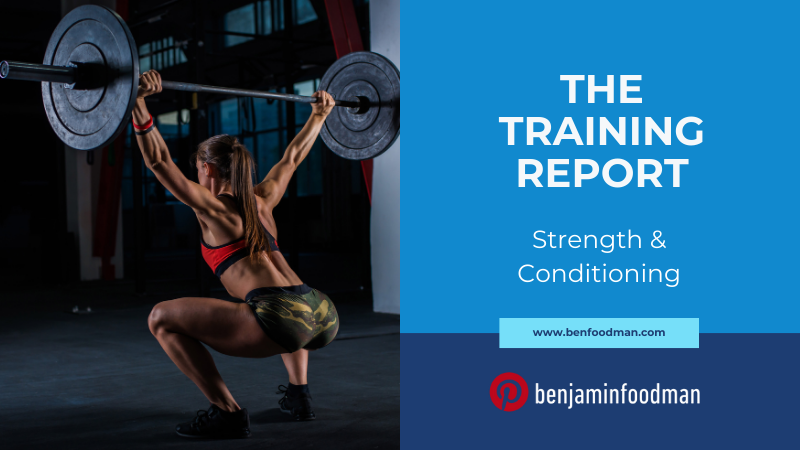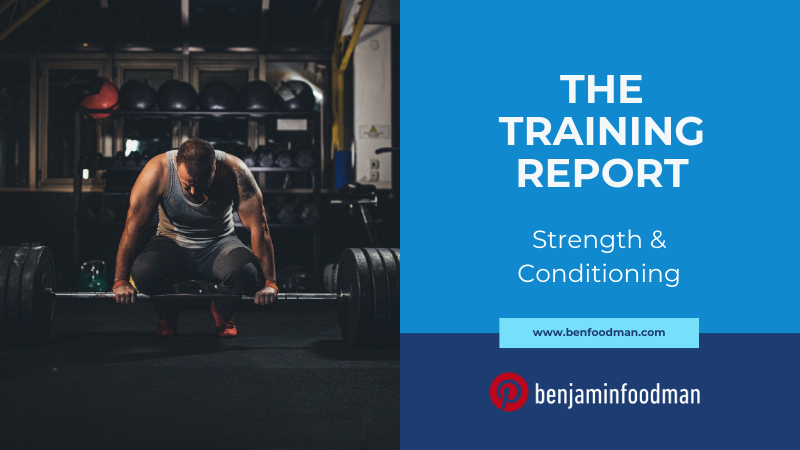Strength & Conditioning - Exercise Science Periodization Strategies Part III. Athlete Maximum Strength & Mental Performance
About the Author
Ben Foodman is a licensed psychotherapist & performance specialist. He owns his private practice located in Charlotte North Carolina where he specializes in working with athletes to help them overcome mental blocks (the yips), PTSD, ADD / ADHD and achieve flow states through the techniques of Brainspotting & Neurofeedback. If you are interested in services, use the link here! Enjoy the article below!
Introduction: How Athletes Can Use Specific Periodization Strategies To Enhance Maximum Strength Development
When athletes are trying to enhance their performance outcomes, they turn to different strength & conditioning methods that will give them the edge over their competition. Regardless of the sport, most if not all athletes would benefit from incorporating some form of maximum strength training. However, most athletes are either poorly informed or do not have the proper experts to confirm WHY and HOW they should begin maximum strength training.
Because this is such a common issue that athletes need to learn more about, I wanted to use this issue of the Training Report to review the science behind maximum strength training. In part I. we will first review how to define maximum strength training. Next in part II., we will review the peer-reviewed scientific explanations for WHY athletes should incorporate maximum strength training into their regimen, and finally in part III. we will review a sample program that guides athletes on HOW to design a maximum strength training program. Let’s first review how to define this issue.
Part I. Defining Maximum Strength Training In Sports Performance Development
Maximum strength has been defined as the highest force that can be exerted by the neuromuscular system during a contraction. ‘This quality is increased through a combination of structural adaptation (hypertrophy) and, mostly, neural adaptation (mainly in the form of improved intermuscular and intramuscular coordination). Maximum strength refers to the heaviest load that an athlete can lift in one attempt and is expressedd as 100 percent of maximum or 1 RM. For training purposes, athletes must know their maximum strength for the most important (fundamental) exercises because it provides the basis for calculating loads for almost every strength phase’.
While strength & conditioning has come a long way, many athletes do not have access to Certified Strength & Conditioning Specialists (CSCS) or exercise science experts who possess the knowledge on understanding what maximum strength is, and why it needs to be developed in a very specific manner. In fact, many athletes would be surprised to learn that there is a vast misunderstanding about these concepts at even the professional sports level. Because developing maximum strength is a critical aspect towards achieving peak potential in an athlete’s performance career, let’s dive into the science that explains WHY athletes need to incorporate maximum strength training into their programming.
Part II. The Science Behind Maximum & Submaximum Strength Development For Athletes (& How It Enhances Mental Performance)
In the book Periodization Training For Sports, 3rd Edition by Tudor Bompa & Carlo Buzzichelli, the authors review the explanations and reasons for why athletes need to incorporate this form of training into their regimen: In periodization of strength for sports, the submaximum and maximum load methods are probably the most effective ways to develop maximum strength. Improving maximum strength is paramount for most sports for the following reasons:
The increases in voluntary motor unit activation results in high recruitment of fast-twitch muscle fibers that transfers to any sport activity
Maximum strength is the determinant factor in increasing power. As such, it enables the athlete to reach a high neural output for sports in which speed and power are dominant
Maximum strength is also a critcal element in improving muscular endurance, especially of short and medium duration
Maximum strength is important for sports in which relative strength is crucial, such as martial arts, boxing, wrestling, sprinting, and jump events in track and field and most team sports. Relative strength is the proportion between maximum strength and body weight, meaning that the higher the relative strength is, the better the performance will be
The authors continue: Submaximum and maximum load methods positively influence athletes in speed and power dominant sports by increasing the muscle size and recruitment of more fast twitch fibers. Although large increases in muscle size are possible for athletes who are just starting to use these methods, they are less likely in athletes with longer training backgrounds, though they too will steadily put on small amounts of functional muscle mass as their training loads increase over time. The greatest gains in maximum strength, however, result from better muscle group coordination and increased recruitment of fast twitch motor units. The load used for maximum strength development - 70 percent to 90 percent of 1 RM for only one to five reps result in sets of short duration and, combined with complete rest intervals, allow complete restoration of ATP. As a result, the ATP deficiency and the depletion of structural protein are too low to strongly activate the protein metabolism that stimulates hypertrophy. Consequently, when used with sufficient rest intervals, such loads result in an increase in maximum strength but not so much in hypertrophy unless total volume (i.e., high total time under tension) is high enough. The submaximum and maximum load methods also increase testosterone level, which further explains improved maximum strength. The level of testosterone in the blood appears to depend on the frequency (per day and per week) of sessions using the maximum load method.
In addition to the physical benefits of maximum strength training, there are incredible mental benefits as well, which may be just as important. When we look at the research, what we see is that athletes who regularly train will accumulate the following mental benefits: new brain cells which increase the volume of the hippocampus which improves long-term memory, improved attention function, and long lasting increases in mood and focus. When you think about the psychological demands of sports, it’s easy to understand why it would be critical for athletes to improve in these areas. Furthermore athletes are ‘hitting two birds with one stone’ by training both the mind and body during strength training, which in turn is much more time efficient. Now that we have reviewed the WHY, lets go through a sample program that reviews the HOW.
Part III. Sample Program Design For Developing Maximum Strength In Athletes
Olympic-Class Sprinter Case Sample
Exercise - Tempo - Rest Interval - Week + Loading Pattern (MEDIUM = M, HIGH = H, LOW = L) 1. 2. 3. 4. 5. 6. 7. 8. 9.
Half Squat - 3.0. X - 3 - 75/3 4 M. 80/3 3 H. 70/1 4 L. 82.5/3 3 M. 85/3 3 H. 70/1 4 L. 87.5/2 3 M. 90/2 3 H. 70/1 4 L.
Bench Press - 3.0. X - 3 - 75/3 4 M. 80/3 3 H. 70/1 4 L. 82.5/3 3 M. 85/3 3 H. 70/1 4 L. 87.5/2 3 M. 90/2 3 H. 70/1 4 L.
Hip Thrust - 3.0. X - 3 - 75/3 4 M. 80/3 3 H. 70/1 4 L. 82.5/3 3 M. 85/3 3 H. 70/1 4 L. 87.5/2 3 M. 90/2 3 H. 70/1 4 L.
Back Hyperextension - 3.0 X - 2 - 3x8 M. 3X8 H. 1X8 L. 3X6 M. 3X6 H. 1X6 L. 3X5 M. 3X5 H. 1X5 L.
Military Press - 3.0 X - 2 - 3x10 M. 3X10 H. 1X10 L. 3X8 M. 3X8 H. 1X8 L. 3X6 M. 3X6 H. 1X6 L.
Standing Calf Raise - 3.0 X - 2 - 3x10 M. 3X10 H. 1X10 L. 3X8 M. 3X8 H. 1X8 L. 3X6 M. 3X6 H. 1X6 L.
Crunch - 3.0 X - 1 - 3x10 M. 3X10 H. 1X10 L. 3X8 M. 3X8 H. 1X8 L. 3X6 M. 3X6 H. 1X6 L.
Note To Reader:
If you are an athlete reading this segment of the TRAINING REPORT, hopefully this content was helpful! I put the Training Report together because I felt like many of the discussions on issues such as the Yips/mental blocks, strength training & other subject matter on athlete performance concepts were really missing the mark on these ideas (e.g. how trauma is the direct cause of the Yips). If you are interested in learning more, make sure to subscribe below for when I put out new content on issues related to sport psychology & athlete performance! Also, if you are looking to work with a mental performance specialist, you are in the right place! USE THIS LINK to reach out to me to see if my services are the right fit for your goals!
ARE YOU ON THE LIST?
Make sure you’re signed up to Ben’s mailing list to receive news & updates on new strategies in sport psychology, upcoming workshops & products. Don’t wait, sign up now!


























